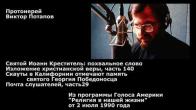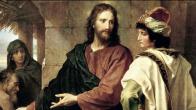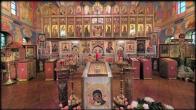You are here
Spirituality of the Christian West and the Orthodox East
All the deviations of the Roman Catholic confession from the ideals of the ancient, undivided Church could not but affect its spiritual life. M.V. Lodyzhensky, in the second volume of his "Mystical Trilogy", compares the spirituality of the Eastern and Western Churches using the examples of Venerable Seraphim of Sarov and Francis of Assisi. This is not by chance, since in the West the sanctity of Venerable Seraphim is thought to resemble the righteousness of the friar of Assisi. Here are the main conclusions at which Lodyzhensky arrives in his comparison:
"In the mystic of the East, in the person of Saint Seraphim of Sarov, we see an example of man's complete regeneration... ...that the super-consciousness of the ascetic of the East is concentrated in his flaming heart. There - within himself - he perceives the fire of the Godhead, he perceives Christ. This feeling of his inner unity with God descends upon him naturally and freely, as a direct result of growth, as a result of work on himself on the path of humility and repentance. According to the mysticism of the East, all these descents of higher perceptions are for the humble man beyond expectation, for the ascetic, in accordance with his humility, does not even feel himself worthy of this" (Mystical Trilogy, v. 2 - "Light Unseen", Petrograd, 1915, pages 156-157 [in Russian]).
The spiritual vision of the ascetic of the East is turned toward his inner world, according to Christ's word, "the Kingdom of God is within you" (Luke 17:21). The source of the spirituality of the western saints is different. Again Lodyzhensky:
"St. Francis, in his notion of Christ, was struck most of all by the earthly life of Christ, by His image of suffering. This impression came to Francis from without, and Francis thirsted for visions of the suffering Christ. Proceeding from an external impression, from an image of Christ and His sufferings, the mysticism of St. Francis developed. This resulted in the mysticism of Francis having to deviate toward the imagination and sensuality, for, if Christ was for Francis an object, if he came to a notion of Christ from an external impression, one of the means for developing this mysticism was the stimulation of the imagination toward this external impression. And if the imagination was stimulated, then sensuality also had to be affected" (ibid., page 157).
The spirituality of Francis of Assisi is characteristic of the spirituality of the whole Roman Catholic Church. It is all sensual and oriented toward the Saviour's external feat. This does not mean that the Orthodox Church does not impart significance to this feat; but she always seeks the inner meaning of this feat, its inner light and repose. It is not superfluous here to touch upon the question of hesychasm and the place of Saint Gregory Palamas in confirming this Orthodox teaching.
The Greek word "hesychia" signifies peace, repose. The hesychast monks, besides various other spiritual exercises, uninterruptedly practiced the Jesus Prayer, that is, they continually repeated the words: "Lord Jesus Christ, Son of God, have mercy on me, a sinner." Such praying not infrequently was accompanied by special bodily techniques, for example, by prostrations, by a bent over posture of the body while sitting, by rhythmical breathing.
Monks who had long practised such prayer attained a lofty state of spirit, perceived the manifest grace-filled presence of God in their hearts and in a radical manner eliminated from their consciousness not only sinful, but all involuntary notions and feelings; they were wholly absorbed in contemplating God. The hesychast monks who were successful in this prayer not infrequently received gifts of prophetical clairvoyance, and they promoted the enlightenment of the people surrounding them and of those who resorted to their spiritual help. In a word, the influence of these monks, who lived mainly on Athos, was very powerful during the epoch of Gregory Palamas.
In the thirteenth century, when rationalism, emanating from the Latin West, began to spread, certain theologians raised their voices against the hesychasts.
The main thing against which the rationalists rose up was the faith of the ascetics that they could be deemed worthy of true divine communion and that that spiritual light which illumined them interiorly was that very same light that transfigured Christ on Mount Tabor.
The opponents of the hesychasts asserted that the Essence of God is unapproachable for man, and that God, only as it were from afar, illumines chiefly the thoughts of men and in this way directs human behavior.
Hierarch Gregory Palamas, Archbishop of Thessalonica, came out in defense of the hesychasts. He declared that the practice of the hesychasts was an ancient Christian phenomenon, that there were no innovations here whatsoever and that drawing near to God in prayer had its basis in the mysteries of the Church, through which man receives the seed of true grace.
But Palamas' main contribution to theology was his teaching on the divine energies. He demonstrated that if communion with the Divine Essence Itself is unattainable, all the same, man has the possibility of genuine divine communion and contact with God, since God, out of love for man, communes with him through His special energies or powers.
According to the teaching of Gregory Palamas, God has, as it were, two forms of existence: one form is the proper life of the Godhead, which is inaccessible to us, and His Essence; the other is God's constant advertence toward His creation. Thus, we can commune with God, Who is turned toward us through his energies, and obtain from Him various grace-filled gifts.
The teaching of Gregory Palamas, expounded by him in the fourteenth century, explained and consolidated the teaching of the ancient Fathers of the Church, who had written that man is created for transfiguration, for deification. By this teaching, faith in the efficacy, in the reality of the whole sacramental life of the Church and of prayers was strengthened.
The sensuality of Roman Catholic spirituality is particularly striking in its prayers and ecclesiastical art. Let us compare the well-known prayer of Ignatius of Loyola, which is revered in the Catholic Church to the same degree that the Lenten prayer of Venerable Ephraim the Syrian, "O Lord and Master of my life...", is revered by us. Here is the prayer of Ignatius of Loyola:
Soul of Jesus, sanctify me,
Body of Jesus, save me,
Blood of Jesus, grant me rest,
Water from the side of Jesus, cleanse me,
Sufferings of Jesus, strengthen me,
O good Jesus, hear me.
Let us compare an Orthodox prayer, taken from the Akathist for Communion of the Holy Mysteries (First Ekos), analogous to this Catholic prayer:
Jesus, burn up the thorns of my many transgressions.
Jesus, create in me a clean heart and renew a right spirit within me.
Jesus, bring my poor soul out of the prison of the passions.
Jesus, destroy in me unclean thoughts and evil lusts.
Jesus, direct my feeble steps on the path of Thy command-ments.
Jesus, God of my heart, come and unite me with Thee forever.
The manifest spiritual difference, which is noticed in these prayers, strikes one to an equal degree while examining the sacred art of the West and East.
In the Orthodox notion, the icon depicts the world glorified; in it there ought not be anything earthly or worldly. Therefore, the techniques of depiction are altogether different from those that are used in realistic painting.
Rome has completely departed from classical Byzantine fundamentals. This was expressed particularly forcefully during the epoch of the Renaissance. The very philosophical direction of this period hymns man's egoism and powerfulness, his self-perception in the surrounding and material environment. As a result, the ecclesiastical art of the West also headed along this path - along the path of free creativity, independent of the Church and its enactments. A free attitude toward Church ideas and the mixing of Church traditions with contemporary reality resulted in Western religious art allowing, by striving toward human earthly beauty and sensuality, the distortion of the sacred image.
That which the ancient Church so painstakingly avoided - the influence of antique pagan painting and realism - was in full measure reborn in Western Christianity and has covered the walls of the largest Catholic churches and cathedrals. Naked bodies, contemporary dress and decor became the norm, while spiritual beauty was brought down to something worldly and everyday.
©V. Potapov, 1996-98
PARISH LIFE
RECENT VIDEOS
Address of our Cathedral
Subscribe to our mailing list
While all the materials on this site are copyrighted, you may use them freely as long as you treat them
with respect and provide attribution on the Russian Orthodox Cathedral of St.John the Baptist of Washington DC.









